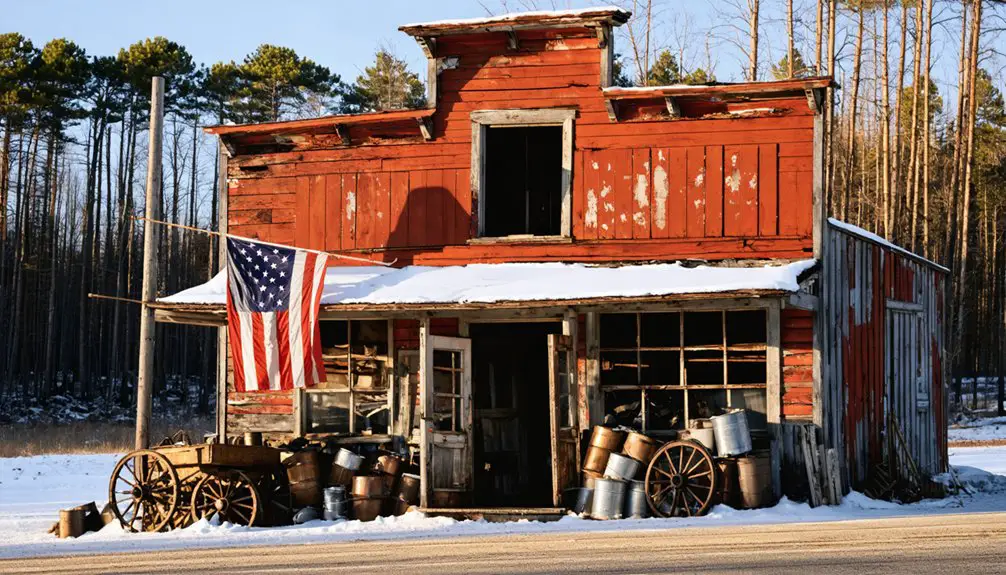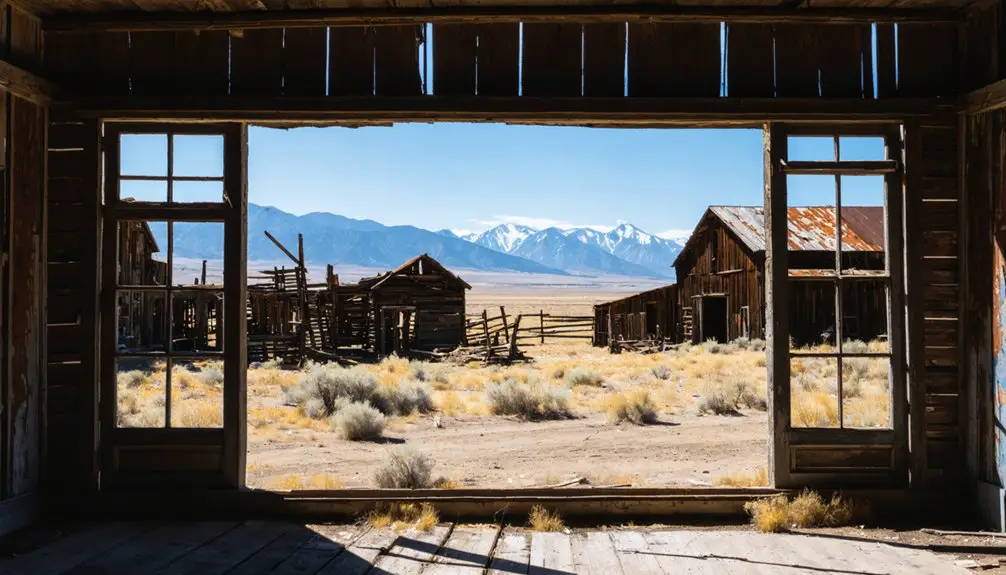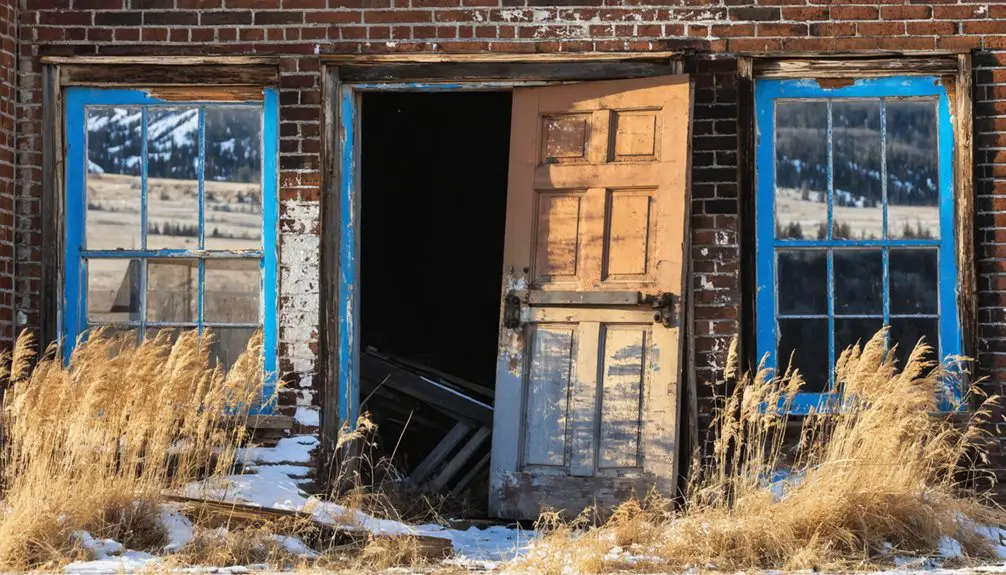You’ll discover Trapper City’s remains near present-day Melrose, Montana, where this silver boomtown briefly flourished in the 1870s. Originally called Burnt Pine City, it grew to 200 residents after James Bryant’s discovery of the Trapper Lode in 1873. The town boasted hotels, saloons, and the profitable Forest Queen mine, which helped the district produce over $22 million in silver ore. Today’s scattered ruins tell a larger tale of Montana’s mining frontier.
Key Takeaways
- Trapper City was established in 1873 following the discovery of Trapper Lode, becoming the first settlement in Montana’s Hecla Mining District.
- Originally named Burnt Pine City, the settlement grew to 200 residents with general stores, hotels, and saloons during its mining boom.
- The town flourished from silver, lead, copper, and zinc mining, producing approximately $20 million in minerals during its active period.
- Trapper City declined by 1878 as nearby Hecla grew into a larger mining town with better infrastructure and company support.
- Today, scattered remnants of Trapper City can be accessed via four-wheel drive vehicles, marking its legacy as a Montana ghost town.
The Birth of a Mining Camp
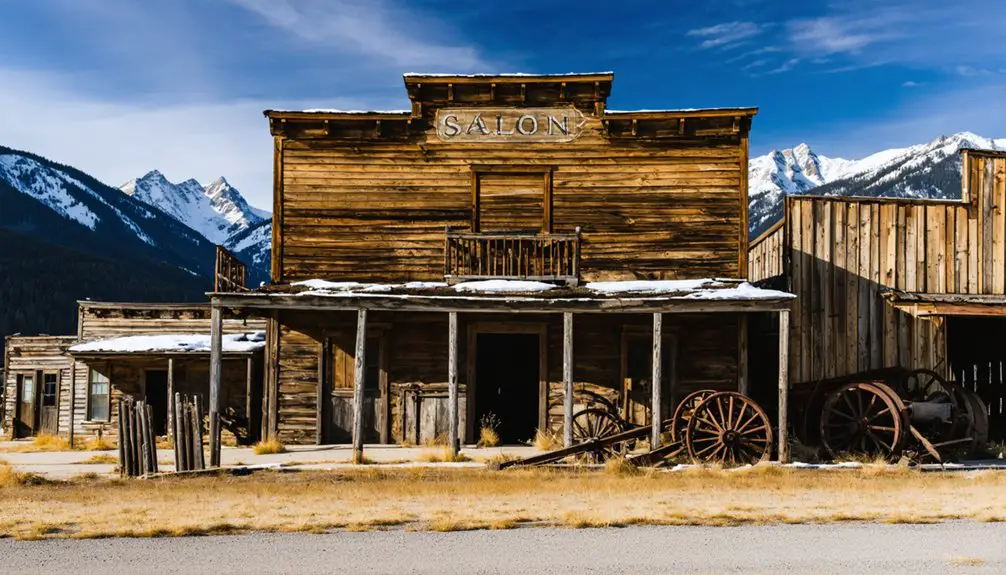
When silver ore glinted in Montana’s sunlight back in 1873, James Bryant and his fellow prospectors knew they’d struck it rich with the discovery of the Trapper Lode. The camp establishment quickly followed, as fortune seekers from Bannack rushed to stake their claims in what would become the first settlement of the Hecla Mining District.
You could’ve witnessed the birth of a mining legacy as Trapper City sprouted along the creek, complete with its own post office. The promise of silver, lead, copper, and zinc drew nearly 200 residents to this rugged outpost. The area would later develop into a thriving community with water works system and fire protection.
They’d haul their precious ore by pack trains and wagons to Corinne, Utah, before sending it on to Denver’s smelters. Early claims like the Forest Queen in 1872 proved there was wealth hiding in these Montana hills. The district would eventually produce minerals worth nearly $20 million during its heyday.
Early Days and Notable Structures
Life in the newly established Trapper City revolved around the heart of the settlement, originally known as “Burnt Pine City” due to a devastating wildfire that had scorched the forests three miles south.
Nestled in fire-scarred wilderness, Trapper City rose from the ashes of its former identity as Burnt Pine City.
As mining techniques evolved, you’d find the town quickly sprouting essential structures along Trapper Creek, where community events often centered around John Cannovan’s prominent hotel and livery stable.
You could’ve witnessed the daily bustle of miners stopping at the general store and butcher shop, while evenings came alive at the saloons.
The post office, established in 1874 under Daniel Parker’s watch, kept you connected to the outside world.
Along the creek, simple cabins housed the hardworking miners and their families, creating a makeshift community of roughly 200 souls seeking their fortunes in this rugged frontier.
Like many mining communities of the era, Trapper City eventually became one of the numerous ghost towns scattered across Montana’s landscape.
Like many entries about historic places, details about Trapper City needed careful disambiguation to distinguish it from other similarly named locations.
Silver Rush and Mining Operations
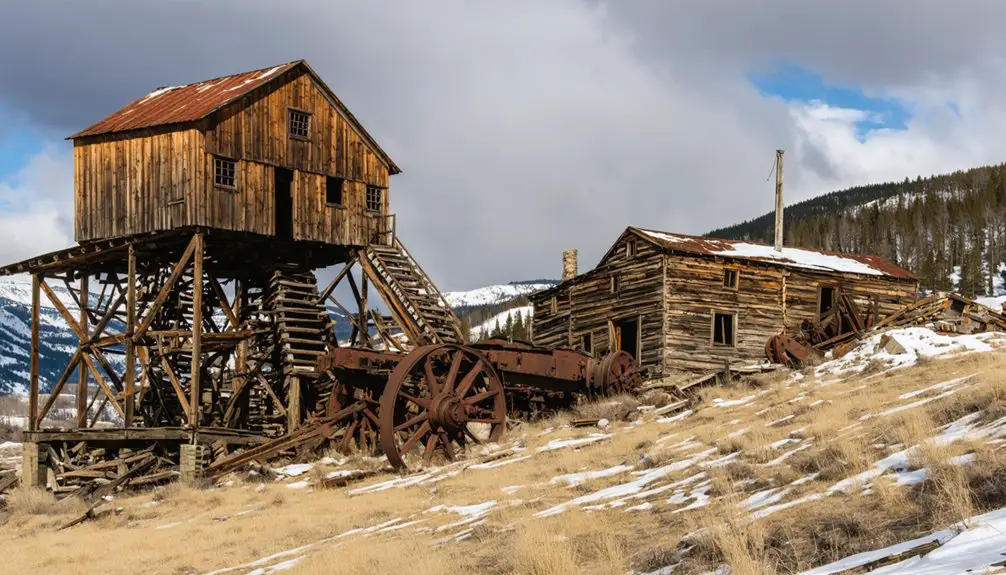
The discovery of the Forest Queen claim in 1872 by William Spurr and James Bryant marked the beginning of Trapper City’s silver boom, though you wouldn’t have seen much activity until Bryant returned with partners the following year.
The discovery of the Trapper Lode transformed this remote Montana wilderness into a bustling hub of silver mining operations. This period of growth aligned with the Bland-Allison Act, which stimulated silver mining across Montana through mandatory government purchases.
You’d have witnessed pack trains and wagons hauling rich silver and lead ore to Corinne, Utah, before it made its way to Denver’s smelters.
The community dynamics shifted as successful mining operations drew people uphill, following the ore veins.
At its peak, nearly 200 freedom-seeking miners and entrepreneurs called Trapper City home, though by 1878, most had moved to newer settlements like Lion City and Hecla as the mining activity migrated.
Life in the Bustling Frontier Town
Despite its brief existence, Trapper City emerged as a vibrant frontier settlement where you’d have found all the essential trappings of an 1870s mining town. The bustling community of 200 residents centered around key establishments like the post office, hotel, and saloons, where community gatherings defined the social fabric of daily life.
Living in Trapper City meant embracing the transient lifestyle of the American frontier, where you could:
- Stock up on supplies at the general store and butcher shop
- Find lodging at the hotel run by John Cannovan or in one of the creek-side cabins
- Socialize at multiple saloons that served as the town’s primary meeting spots
The rugged environment and basic amenities tested your resilience, but the promise of silver riches made it all worthwhile.
The Great Migration to Lion City
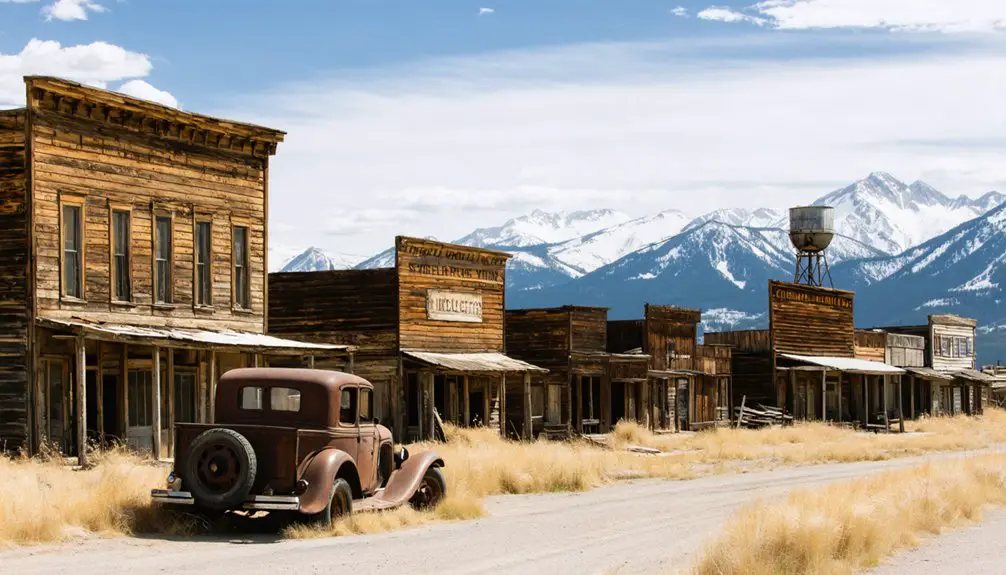
During the late 1870s, Trapper City’s silver-seeking residents began a momentous shift toward the promising slopes of Lion Mountain, where richer ore deposits beckoned.
You’d have witnessed entire buildings being dismantled and rebuilt as the migration patterns transformed the landscape. Businesses, homes, and even the spirited frontier culture made the journey upward to what would become Lion City.
The community dynamics evolved as the population tripled to 600 souls, and you’d have found a more established settlement complete with schools, hotels, and three lively saloons.
Even seasoned pioneers like Andrew “Mose” Morrison relocated his business to the new hub. By 1878, the last residents had abandoned Trapper City, drawn by Lion City’s proximity to the mines and its growing reputation as the district’s commercial center.
Economic Impact and Industrial Growth
You’ll find that Trapper City’s mining district generated astounding wealth, producing over $22 million in silver and lead ore value during the Hecla Mining Company’s peak operations from 1881 to 1900.
The district’s robust transportation network evolved from simple pack trains to sophisticated narrow-gauge tramways and railroad connections, efficiently moving ore to Denver’s smelters.
Local businesses flourished during the boom years, with hotels, saloons, general stores, and banking services supporting a growing workforce that reached 1,800 residents at its height.
Mining Production and Revenue
As Trapper City’s mining operations expanded following the 1873 discovery of the Trapper Lode, the area became a significant producer of gold, silver, lead, copper, and zinc.
Similar to how Gold Rush fever first struck Montana near Deer Lodge in the 1850s, mining revenue flowed steadily as ore was transported to markets in Denver, with the Greenwood Concentrator’s addition in 1882 boosting production efficiency. Similar to the Copper Kings who dominated Butte’s mining industry, wealthy investors competed for control of Trapper City’s valuable mineral resources.
While historical production records don’t specify exact tonnage, the operation’s success supported:
- Advanced infrastructure including blast furnaces, crushers, and a large roaster
- A thriving community of 200 residents with multiple businesses
- Investment in transportation networks connecting to major rail hubs in Utah
Transportation Network Development
Transportation networks proved crucial to Trapper City’s industrial expansion, beginning with the establishment of stagecoach routes that connected the settlement to neighboring communities every 20 miles.
You’d find taverns and horse stations along these routes, following the natural contours of Montana’s rugged terrain, where travelers could rest and change mounts.
The 1880s railroad expansion transformed Trapper City’s accessibility, slashing travel times and enabling efficient shipment of mining resources to distant markets. BNSF Railway remains Montana’s largest freight carrier, maintaining thousands of miles of track throughout the state.
You can still trace some of the original stage roads that once served as lifelines for the region’s early settlers.
While passenger rail service eventually declined, the freight railways continue to serve Montana’s industrial needs, carrying on the legacy of those early transportation corridors that helped establish Trapper City as a crucial mining hub.
Local Business Diversification
While miners worked tirelessly extracting precious metals from Trapper City’s rich veins, savvy entrepreneurs transformed the bustling mining camp into a diverse commercial hub. The success mirrored towns like Virginia City, which thrived through retail and dining establishments.
You’d have witnessed remarkable business resilience as merchants established essential community services beyond mining operations. As most miners had no spare time, entrepreneurs filled needs by providing basic services to the hardworking prospectors.
- Local shops, including general stores, bakeries, and blacksmith shops, sprung up to serve the growing population, often generating higher profits than the mines themselves.
- Entertainment venues and social gathering spots like dance halls and theaters helped create a vibrant community atmosphere.
- Neighboring farms and agricultural ventures emerged to supply fresh produce, reducing dependency on distant suppliers.
This economic diversification helped stabilize Trapper City’s economy, though like many mining towns, it couldn’t sustain itself once the precious metals ran dry and the mines closed.
Transportation Networks and Infrastructure
The rugged mountain paths and winding trails of Trapper City’s mining district once bustled with pack trains and horse-drawn wagons hauling precious silver and lead ore.
You’ll find the transport logistics centered around getting ore from mines like Trapper Lode to Corinne, Utah, where it’d catch the railroad to Denver’s smelters.
As operations grew, so did the infrastructure. By 1882, a four-mile tramway system revolutionized ore movement from Hecla to the Greenwood Concentrator, marking a shift from reliance on pack animals.
The district’s network expanded to include livery stables and warehouses, supporting both mining operations and growing towns like Lion City.
Today, you can trace these historic routes via Trapper Creek Road, though you’ll need a four-wheel drive to navigate the rough terrain.
The Rise of Rival Settlement Hecla
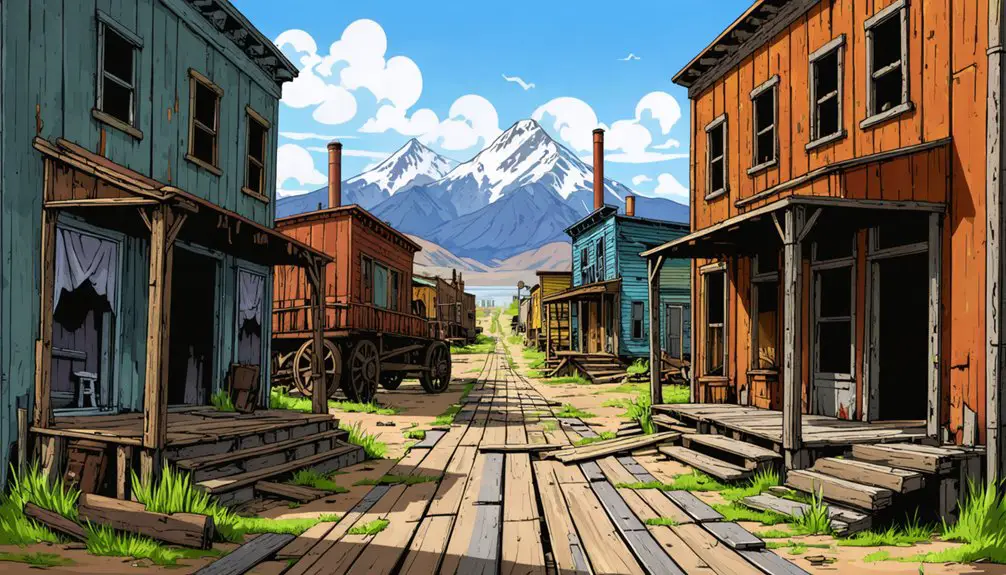
Founded in 1876 near the productive mines of Lion Mountain, Hecla quickly emerged as a formidable rival to Trapper City’s early dominance. Under Henry Knippenberg’s direction, the Hecla rivalry intensified as the settlement grew into a robust company town of 1,500-1,800 residents, complete with advanced mining infrastructure and essential services.
You would’ve witnessed these remarkable developments in Hecla:
- Installation of sophisticated tramways and water systems that served both mining operations and townspeople
- Construction of the Hecla Mercantile & Banking Company, which controlled local commerce
- Development of community facilities including a school for 200 pupils, church, and fire protection services
While Trapper City’s distant location led to its decline, Hecla’s strategic position and company backing secured its place as the district’s primary mining settlement.
Legacy and Present-Day Remnants
Today’s visitors to Montana’s historic Trapper City mining district will find only scattered remnants of its once-bustling settlements, with ruined buildings at Hecla and abandoned structures marking Trapper City’s original location along Trapper Creek.
You’ll need a four-wheel drive vehicle or ATV to explore these ghost town sites, where the legacy preservation efforts reveal glimpses of a thriving past.
While most mining infrastructure has vanished, you can still discover the charcoal kilns near Glendale that once fueled the district’s silver production.
The area’s rich history includes Hecla’s peak population of 1,800 residents, complete with schools and churches, while Trapper City itself boasted saloons, hotels, and shops before its residents moved away in 1878.
Ghost town exploration here offers a raw, unfiltered connection to Montana’s mining heritage.
Frequently Asked Questions
Were There Any Notable Crimes or Lawmen Associated With Trapper City?
Like many Wild West outposts, you won’t find records of specific criminal activities or law enforcement figures in Trapper City’s story, though saloons and brothels suggest typical frontier disorder existed.
What Was the Average Wage of Miners in Trapper City?
You’d find mining wages varied greatly with economic conditions, but specific Trapper City pay rates aren’t documented. They likely matched nearby Butte’s rates, which provided miners a decent living standard.
Did Any Famous People Visit or Live in Trapper City?
All roads lead somewhere, but they didn’t lead famous visitors to Trapper City. While you’d find historical figures like postmaster James L. Hamilton and hotel owner John Cannovan, no celebrities graced this mining town.
What Diseases or Medical Issues Were Common in Trapper City?
You’d face devastating smallpox outbreaks, chronic skin infections from handling pelts, mining injuries, tuberculosis outbreaks, and STDs. Without doctors or medicine, your chances of survival weren’t great in those harsh frontier days.
How Did Severe Weather Affect Mining Operations in Trapper City?
You’d have faced severe storms that paralyzed mining operations, while brutal winter conditions froze equipment, slowed ore processing, and made slag handling treacherous. Transportation routes often became impassable, halting essential supplies.
References
- https://www.legendsofamerica.com/mt-hecla/
- https://en.wikipedia.org/wiki/Hecla
- https://www.geotab.com/ghost-towns/
- https://www.mtghosttowns.com/glendale
- https://westernmininghistory.com/towns/montana/hecla/
- https://mhs.mt.gov/education/textbook/chapter6/Chapter6.pdf
- https://montanakids.com/agriculture_and_business/mining/Early_days_of_Mining.htm
- https://www.glendalemontana.com/trapper-city
- https://ahgp.org/mt/silver_bow_county_montana_1921.html
- https://en.wikipedia.org/wiki/Montana_silver_mining
